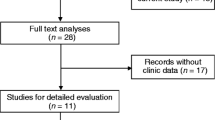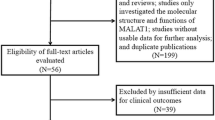Abstract
The metastasis-associated lung adenocarcinoma transcript 1 (MALAT1) is a bona fide long noncoding RNA (lncRNA). LncRNA MALAT1 was discovered as a prognostic factor for lung cancer metastasis but also has been linked to several other human tumor entities. However, little is known about the role of lncRNA MALAT1 in glioma patients. The aim of this study was to identify the role of lncRNA MALAT1 in the pathogenesis of glioma; we analyzed the relationship of lncRNA MALAT1 expression with clinicopathological characteristics in glioma patients. In our results, lncRNA MALAT1 expression was increased in glioma tissues compared with paired adjacent brain normal tissues (P < 0.001). Furthermore, lncRNA MALAT1 was associated significantly with WHO grade (I–II vs. III–IV; P = 0.007) and tumor size (<3 cm vs. T ≥ 3 cm; P = 0.008). However, lncRNA MALAT1 expression was not associated significantly with age (<45 vs. ≥45, P = 0.343), gender (female vs. male, P = 0.196), family history of cancer (yes vs. no, P = 0.665), and tumor location (supratentorial vs. infratentorial, P = 0.170). Moreover, the level of lncRNA MALAT1 expression was markedly correlated with the glioma patients’ overall survival (P < 0.001). Multivariate analysis suggested that increased lncRNA MALAT1 expression was a poor independent prognostic predictor for glioma patients (P = 0.002). In conclusion, lncRNA MALAT1 plays an important role on glioma progression and prognosis and may serve as a convictive prognostic biomarker for glioma patients.


Similar content being viewed by others
References
Siegel R, Ma J, Zou Z, Jemal A. Cancer statistics, 2014. CA Cancer J Clin. 2014;64:9–29.
Jemal A, Bray F, Center MM, Ferlay J, Ward E, Forman D. Global cancer statistics. CA Cancer J Clin. 2011;61:69–90.
Louis DN, Ohgaki H, Wiestler OD, Cavenee WK, Burger PC, Jouvet A, et al. The 2007 WHO classification of tumours of the central nervous system. Acta Neuropathol. 2007;114:97–109.
Dellaretti M, Reyns N, Touzet G, Dubois F, Gusmao S, Pereira JL, et al. Diffuse brainstem glioma: prognostic factors. J Neurosurg. 2012;117:810–4.
Johnson DR, Galanis E. Incorporation of prognostic and predictive factors into glioma clinical trials. Curr Oncol Rep. 2013;15:56–63.
Esteller M. Non-coding RNAs in human disease. Nat Rev Genet. 2011;12:861–74.
Maruyama R, Suzuki H. Long noncoding RNA involvement in cancer. BMB Rep. 2012;45:604–11.
Sun Y, Wang Z, Zhou D. Long non-coding RNAs as potential biomarkers and therapeutic targets for gliomas. Med Hypotheses. 2013;81:319–21.
Qureshi IA, Mehler MF. Emerging roles of non-coding RNAs in brain evolution, development, plasticity and disease. Nat Rev Neurosci. 2012;13:528–41.
Han L, Zhang K, Shi Z, Zhang J, Zhu J, Zhu S, et al.: Lncrna pro fi le of glioblastoma reveals the potential role of lncrnas in contributing to glioblastoma pathogenesis. International journal of oncology 2012;40:2004–12
Zhang X, Sun S, Pu JK, Tsang AC, Lee D, Man VO, et al. Long non-coding RNA expression profiles predict clinical phenotypes in glioma. Neurobiol Dis. 2012;48:1–8.
Zhang XQ, Sun S, Lam KF, Kiang KM, Pu JK, Ho AS, et al. A long non-coding RNA signature in glioblastoma multiforme predicts survival. Neurobiol Dis. 2013;58:123–31.
Zhang JX, Han L, Bao ZS, Wang YY, Chen LY, Yan W, et al. Hotair, a cell cycle-associated long noncoding RNA and a strong predictor of survival, is preferentially expressed in classical and mesenchymal glioma. Neuro-Oncology. 2013;15:1595–603.
Zhang X, Zhou Y, Mehta KR, Danila DC, Scolavino S, Johnson SR, et al. A pituitary-derived meg3 isoform functions as a growth suppressor in tumor cells. J Clin Endocrinol Metab. 2003;88:5119–26.
Tripathi V, Ellis JD, Shen Z, Song DY, Pan Q, Watt AT, et al. The nuclear-retained noncoding RNA malat1 regulates alternative splicing by modulating sr splicing factor phosphorylation. Mol Cell. 2010;39:925–38.
Ji P, Diederichs S, Wang W, Boing S, Metzger R, Schneider PM, et al. Malat-1, a novel noncoding RNA, and thymosin beta4 predict metastasis and survival in early-stage non-small cell lung cancer. Oncogene. 2003;22:8031–41.
Schmidt LH, Spieker T, Koschmieder S, Schaffers S, Humberg J, Jungen D, et al. The long noncoding malat-1 RNA indicates a poor prognosis in non-small cell lung cancer and induces migration and tumor growth. J Thorac Oncol : Off Pub Int Assoc Study Lung Cancer. 2011;6:1984–92.
Luo JH, Ren B, Keryanov S, Tseng GC, Rao UN, Monga SP, et al. Transcriptomic and genomic analysis of human hepatocellular carcinomas and hepatoblastomas. Hepatol (Baltimore). 2006;44:1012–24.
Lin R, Maeda S, Liu C, Karin M, Edgington TS. A large noncoding RNA is a marker for murine hepatocellular carcinomas and a spectrum of human carcinomas. Oncogene. 2007;26:851–8.
Han Y, Liu Y, Nie L, Gui Y, Cai Z. Inducing cell proliferation inhibition, apoptosis, and motility reduction by silencing long noncoding ribonucleic acid metastasis-associated lung adenocarcinoma transcript 1 in urothelial carcinoma of the bladder. Urology. 2013;81:209 e1–7.
Ying L, Chen Q, Wang Y, Zhou Z, Huang Y, Qiu F. Upregulated malat-1 contributes to bladder cancer cell migration by inducing epithelial-to-mesenchymal transition. Mol BioSyst. 2012;8:2289–94.
Fellenberg J, Bernd L, Delling G, Witte D, Zahlten-Hinguranage A. Prognostic significance of drug-regulated genes in high-grade osteosarcoma. Mod Pathol : Off J United States Can Acad Pathol. 2007;20:1085–94.
Lai NS, Dong QS, Ding H, Miao ZL, Lin YC. Microrna-210 overexpression predicts poorer prognosis in glioma patients. J Clin Neurosci : Off J Neurosurg Soc Australas. 2014;21:755–60.
Wang P, Ren Z, Sun P. Overexpression of the long non-coding RNA meg3 impairs in vitro glioma cell proliferation. J Cell Biochem. 2012;113:1868–74.
Guffanti A, Iacono M, Pelucchi P, Kim N, Solda G, Croft LJ, et al. A transcriptional sketch of a primary human breast cancer by 454 deep sequencing. BMC Genomics. 2009;10:163.
Praz V, Jagannathan V, Bucher P. Cleanex: a database of heterogeneous gene expression data based on a consistent gene nomenclature. Nucleic Acids Res. 2004;32:D542–7.
Yamada K, Kano J, Tsunoda H, Yoshikawa H, Okubo C, Ishiyama T, et al. Phenotypic characterization of endometrial stromal sarcoma of the uterus. Cancer Sci. 2006;97:106–12.
Tripathi V, Shen Z, Chakraborty A, Giri S, Freier SM, Wu X, et al. Long noncoding RNA MALAT1 controls cell cycle progression by regulating the expression of oncogenic transcription factor B-MYB. PLoS Genet. 2013;9:e1003368.
Guo F, Li Y, Liu Y, Wang J, Li Y, Li G. Inhibition of metastasis-associated lung adenocarcinoma transcript 1 in CaSki human cervical cancer cells suppresses cell proliferation and invasion. Acta Biochim Biophys Sin. 2010;42:224–9.
Lai MC, Yang Z, Zhou L, Zhu QQ, Xie HY, Zhang F, et al. Long non-coding RNA MALAT-1 overexpression predicts tumor recurrence of hepatocellular carcinoma after liver transplantation. Med Oncol (London, England). 2012;29:1810–6.
Conflicts of interest
None
Author information
Authors and Affiliations
Corresponding author
Additional information
Hong-jie Wang and Kang-xiao Ma are co-first authors.
Rights and permissions
About this article
Cite this article
Ma, Kx., Wang, Hj., Li, Xr. et al. Long noncoding RNA MALAT1 associates with the malignant status and poor prognosis in glioma. Tumor Biol. 36, 3355–3359 (2015). https://doi.org/10.1007/s13277-014-2969-7
Received:
Accepted:
Published:
Issue Date:
DOI: https://doi.org/10.1007/s13277-014-2969-7




